

|
||
My Own Compost Pile. It contains Yard waste, Horse Manure, Kitchen Waste, Wood Ashes, a lot of Lawn and Grass Clippings, Some Leaves, Some Pearlite and of course Urine. I turn it every other day and the heat radiating off it when I turn it is really amazing. I even like the smell (although not everyone feels the same as I do). The dogs love to roll in it - LOL. Today is the 22nd of July. I started this pile at the begining of the summer. It began simply with a bunch of grass trimmings. My wife put up a sign out front that said grass clippings wanted. I also advertised both on Craigs List and Freecycle - a Yahoo group. Later, I found Debra who wanted to get rid of her horse droppings. She and her Husband brought me a whole pickup truck load. I don't remember what day I actually started it but, it's no more than 2 months old. today. |
But how do you know what your pile's ratio is? "The most important factor in estimating the carbon-to-nitrogen ratio is how much water is present," explains Eric Evans, Ph.D., laboratory director of Woods End Research Laboratory in Mt. Vernon, Maine.
"Dry materials are generally in the range of 40 to 50 percent carbon, and sloppy, wet materials are generally 10 to 20 percent carbon." Here are the specifics on many common materials. After you've scanned through these, you'll see how to calculate your pile's exact Carbon/Nitrogen ratio.
Carbon and Nitrogen Content | Material | % Carbon | %Nitrogen |
|---|---|---|
| Alfalfa pellets | 40.5 | 2.7 |
| Blood meal | 43 | 13 |
| Cottonseed meal | 42 | 6 |
| Soybean meal | 42 | 6 |
| Legume hay, dry | 40 | 2.0-2.5 |
| Nonlegume hay, dry | 40 | 1.0-1.5 |
| Fresh manure, cow | 12-20 | 0.6-1.0 |
| Fresh manure, horse | 20-35 | 0.5-1.0 |
| Fresh manure, laying chickens | 10.5-20 | 1.5-3.0 |
| Fresh manure, broiler chickens | 20-32.5 | 1.3-2.0 |
| Wheat or oat straw, dry | 48 | 0.5 |
| Grass clippings, fresh | 10-15 | 1-2 |
| Fallen leaves | 20-35 | 0.4-1.0 |
| Newspaper or cardboard, dry | 40 | 0.1 |
| Wood chips or sawdust | 25-50 | 0.1 |
| Coffee grounds | 25 | 1.0 |
| Vegetable wastes, fresh, leafy | 10 | 1.0 |
| Vegetable wastes, starchy | 15 | 1.0 |
| Kitchen scraps | 10-20 | 1-2 |
| Fruit wastes | 8 | 0.5 |
| Seaweed, fresh | 10 | 1.0 |
| Weeds, fresh | 10-20 | 1-4 |
| * average; based on fresh weight | ||
| Do The Math | ||
| To calculate the carbon-to-nitrogen of your compost mix, use the chart above to find the approximate percentages of carbon and nitrogen in your ingredients. Even if you're unlikely to weigh every ingredient you add to your heap, this formula will give you an idea of how to adjust the proportions of materials in your pile to get finished compost more quickly. | ||
| Calculate your pile's Total Carbon Value by multiplying the percent carbon of each ingredient by the number of parts (by weight) of that ingredient and then adding up the carbon totals for all the ingredients Do the same for the nitrogen. | ||
| Divide the carbon by the nitrogen to get the C:N ratio. If it's between 25 and 35, your pile should compost beautifully. If the ratio is higher or lower than that, adjust the proportions of ingredients to bring it into the range of 25 to 35 parts carbon for each one part nitrogen | ||
| Here's an example of how the carbon-to-nitrogen ratio works when you apply the formula to real-life amounts of real-life compost ingredients: | ||
| Starting with 50 pounds of nonlegume hay, 10 pounds of kitchen scraps, and 2 pounds of coffee grounds:
50 lbs hay x 40% C = 20 lbs. C
50 lbs hay x 1% N = 0.5 lb. N 21.5/0.62 = 34.7 parts carbon to 1 part nitrogen |
||
Compost is organic material that can be used as a soil amendment or as a medium to grow plants. Mature compost is a stable material with a content called humus that is dark brown or black and has a soil-like, earthy smell. It is created by: combining organic wastes (e.g., yard trimmings, food wastes, manures) in proper ratios into piles, rows, or vessels; adding bulking agents (e.g., wood chips) as necessary to accelerate the breakdown of organic materials; and allowing the finished material to fully stabilize and mature through a curing process.
Natural composting, or biological decomposition, began with the first plants on earth and has been going on ever since. As vegetation falls to the ground, it slowly decays, providing minerals and nutrients needed for plants, animals, and microorganisms. Mature compost, however, includes the production of high temperatures to destroy pathogens and weed seeds that natural decomposition does not destroy.
Did You Know That Compost Can...Yard trimmings and food residuals together constitute 23 percent of the U.S. waste stream, as documented by EPA. An estimated 56.9 percent of yard trimmings were recovered for composting or grasscycled in 2000, a dramatic increase from the 12 percent recovery rate in 1990. Accompanying this surge in yard waste recovery is a composting industry that has grown from less than 1,000 facilities in 1988 to nearly 3,800 in 2000. Once dominated by public sector operations, the composting industry is increasingly entrepreneurial and private-sector driven, led by firms that add value to compost products through processing and marketing. Compost prices have been as high as $26 per ton for landscape mulch to more than $100 per ton for high-grade compost, which is bagged and sold at the retail level.
Composting
Before you begin composting, you should understand the composting process. View what materials to compost and what materials not to compost and read up on the science behind composting about which variables must be controlled during composting.
All composting requires three basic ingredients:
Having the right amount of greens, browns, and water is important for compost development. Ideally, your compost pile should have an equal amount of browns to greens and alternate layers of organic materials of different-size particles. The brown materials provide carbon for your compost and the green materials provide nitrogen, while the water provides moisture to help breakdown the organic matter.
There is no one "right" way to compost, but you may want to follow one of the approaches below:
In the above method, Adding the brown materials will keep your pile from solidifying into one big mess but, it will also take longer to break down. You can start with just a bunch of lawn trimmings as long as you turn it often. Also, everything is relative to climate, size of your pile, moisture content, etc. No two compost piles will be the same. Just remember these 2things: Air and Moisture. That's what really gets the job done.
If you do not have space for an outdoor compost pile, you can compost materials indoors using a special type of bin, which you can buy or make yourself. Remember to tend your pile and keep track of what you throw in. A properly managed compost bin will not attract pests or rodents and will not smell bad. Your compost should be ready in 2 to 5 weeks.
A Step By Step pictorial guide to adding new organics and turning your pile. |
||
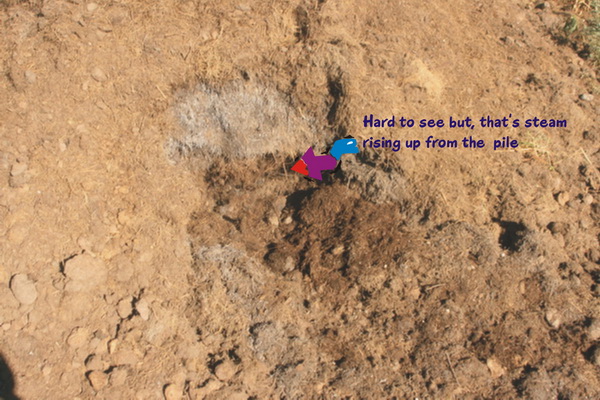 I have just taken a few forkfuls out of the pile to begin turning it (I do this every other day). |
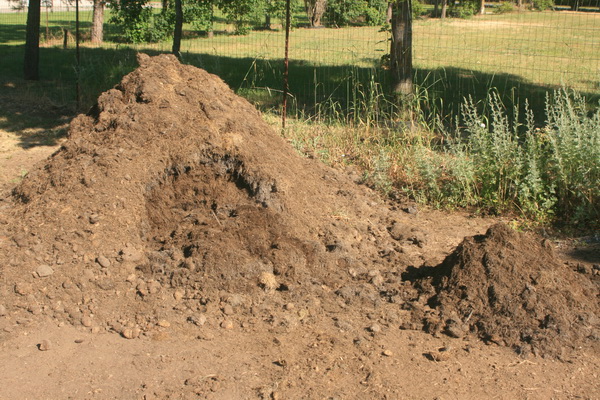 |
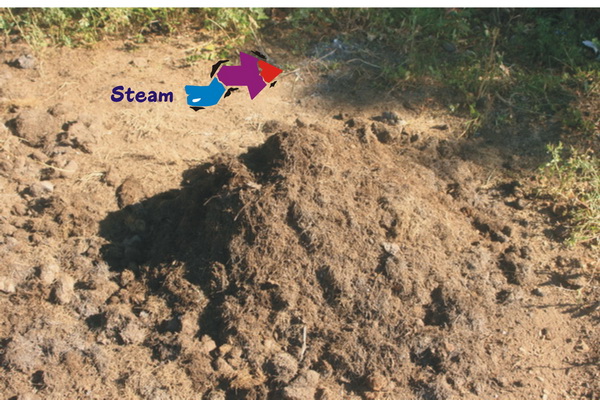 Check out the steam coming off the new pile. |
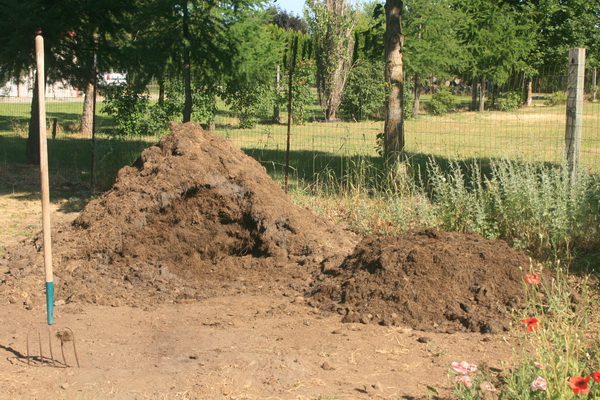 I Prepare the top of the new pile for the addition of yard waste. In this case some leaves and twigs trimmed from an arch project I am building to take a grape vine over a gate so the gate is usable. |
 The leaves and twigs |
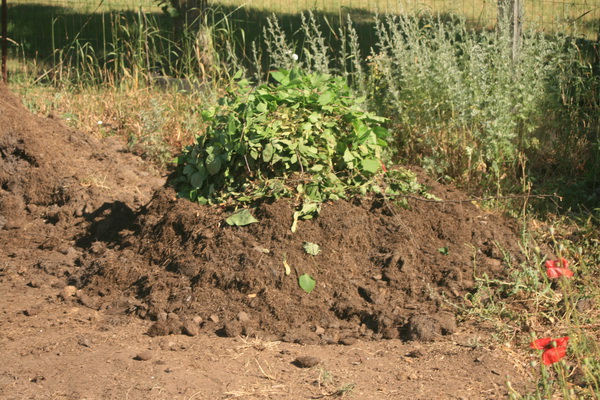 The leaves and twigs added to the top of the new pile. |
 |
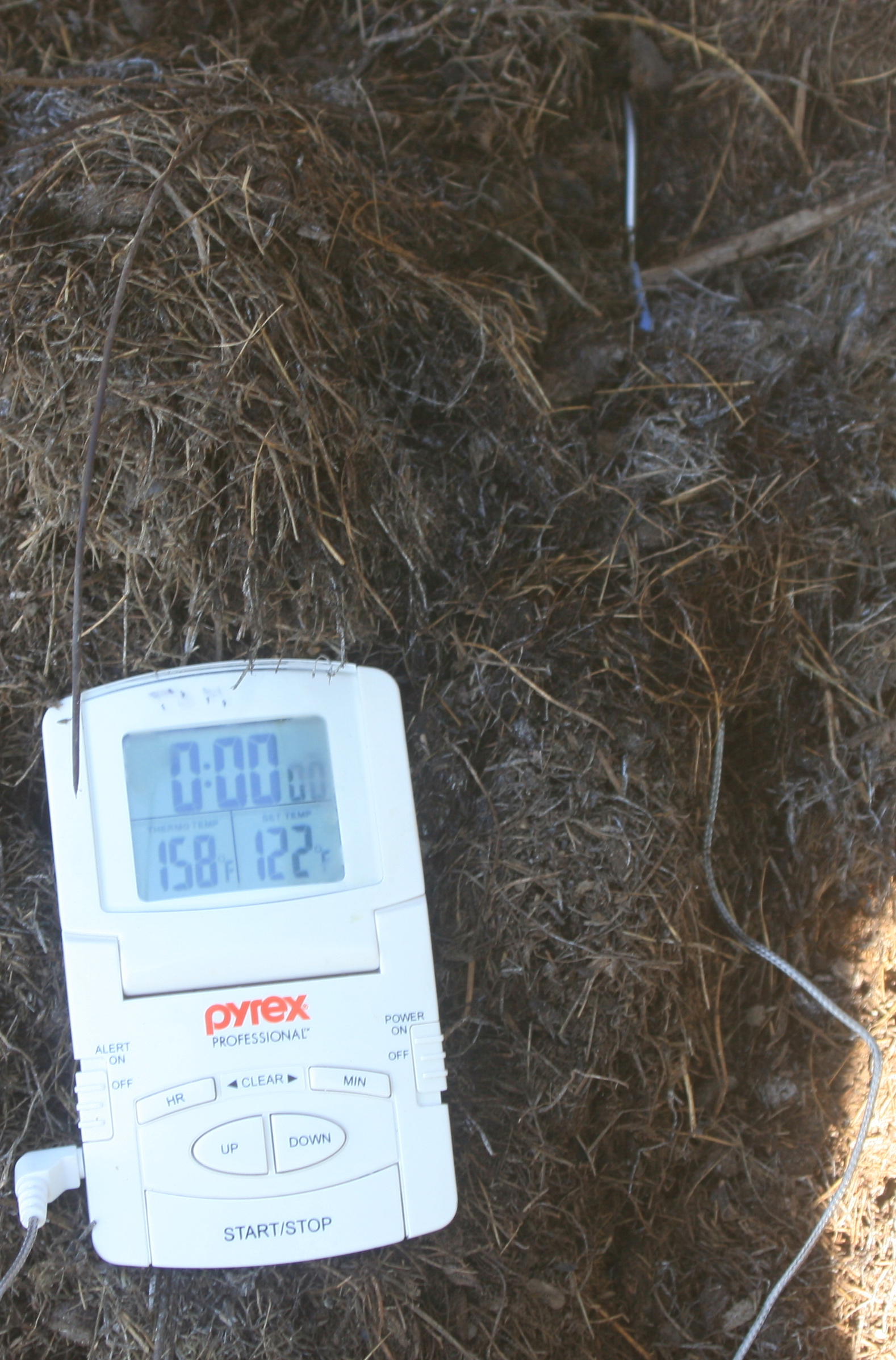 Note the temperature of the interior of the pile. 158°f |
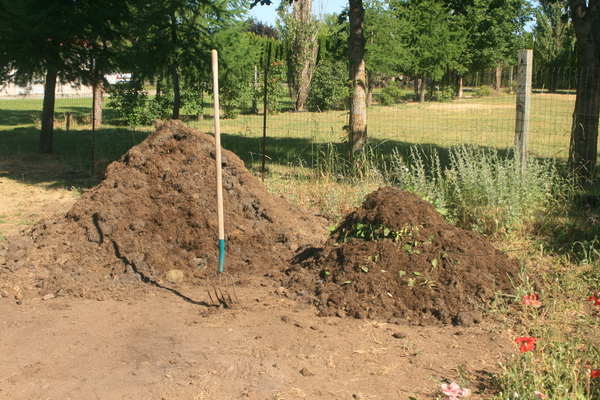 I cover up the new addition. It won't take long to begin to break down. |
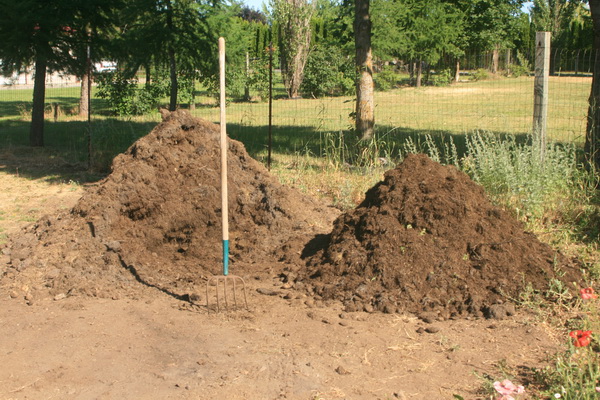 The new addition is almost covered. |
 Over half way done turning the pile. |
 Note the temperature here is 141°f |
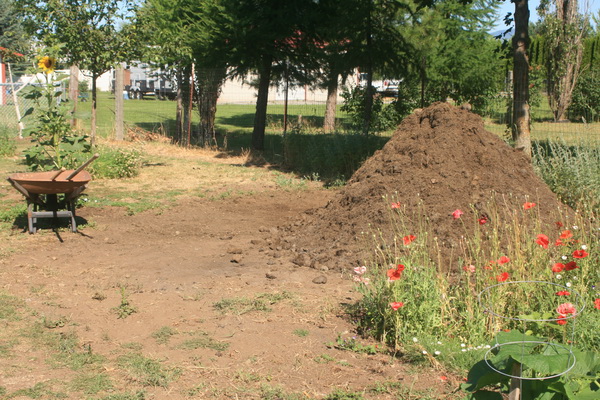 All done. I'll let that sit for a couple days and do it all over again. This time I didn't have to moisten it while I was turning it because it was already adequately moist. The weather has been comfortable in the 80's lateley and I moistened it the last time I turned it. |
||
Today is Tuesday, 2 days later. I will now pick up where I left off the last time. After I turned the pile on Sunday I added 2 bags of grass clippings and some more leaves and twigs. I dumped the grass clippings on the front side and covered it up with a thin layer of dry browns from the back side of the pile just to insulate it a little. I just laid the leaves and twigs on the outside. Monday morning I moisened the pile when I did my morning watering. Today I am going to turn it again and I am really anxious to check out those leaves and twigs I put in the center of the pile on Sunday. When I turn this it will incorporate the grass clippings and will also distribute the new leaves and twigs throughout. Plus, my neighbor in the back has given me that nice big pile of grass clippings you can see off to the side to add to it. |
||
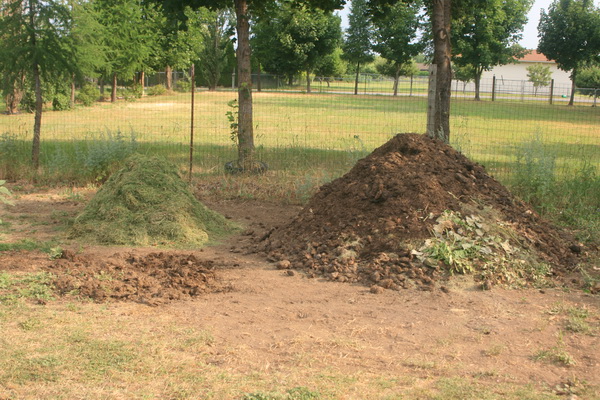 Ready to turn the pile. I have a new pile of grass clippings to incorporate into the pile. I have also dug up the ground a little where I am going to put the turned pile. This is just something I wanted to do so that some of the pile will get into the ground and help it. |
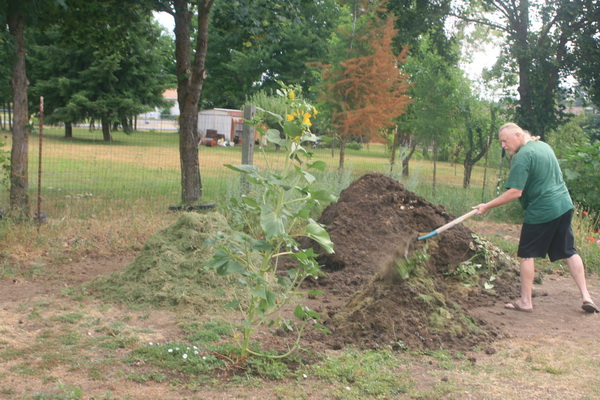 As I dig into the pile you can see the leaves, twigs and grass clippings that were laid on the outside of the pile on Sunday. |
 Notice how after only 2 days the grass clippings have started to decompose and have turned yellow. |
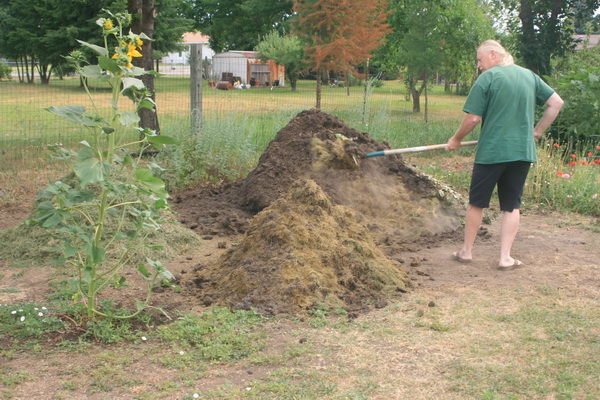 Look at all that steam coming out of the pile. |
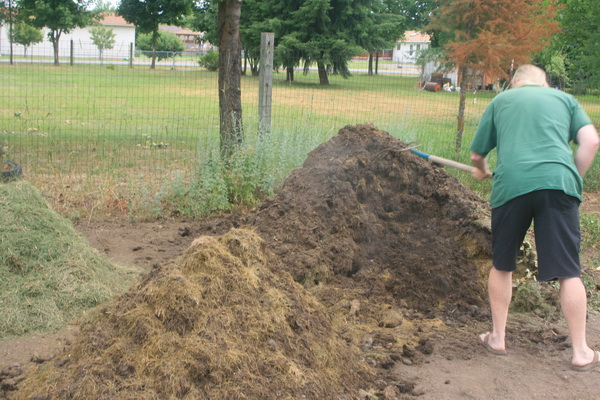 Lots of beautiful steam. |
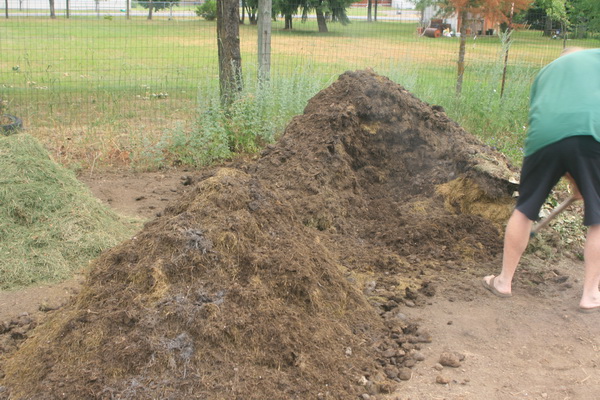 I really like the smell of a well taken care of compost pile. |
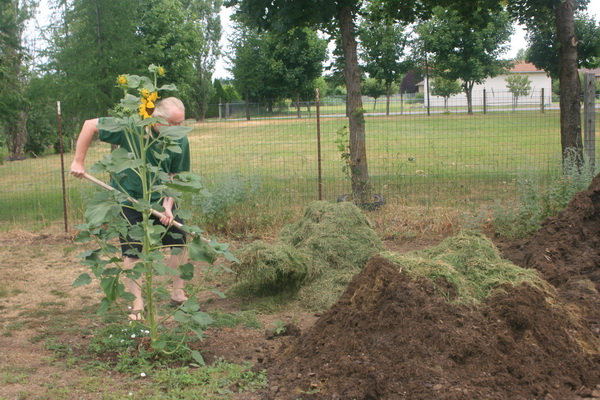 I have a good base and now I begin to incorporate the new grass clippings into the pile. 2 days from now they will be hard to distinguish from the rest of the pile. |
 Kevin is helping me today by documenting my efforts with the camera. He has captured the steam excellently here. Thanks Kevin. |
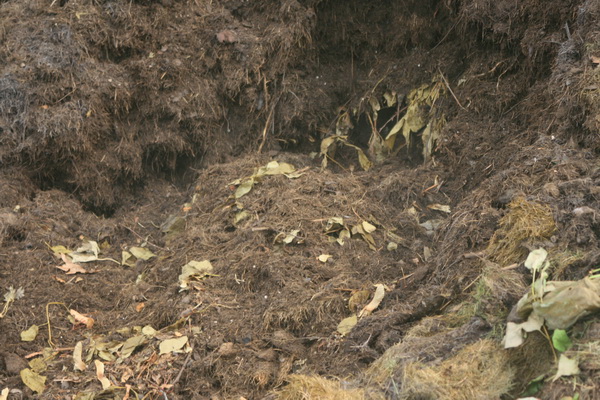 I have just gotten to that bunch of leaves and twigs that I added to the pile on Sunday. Look at their color. |
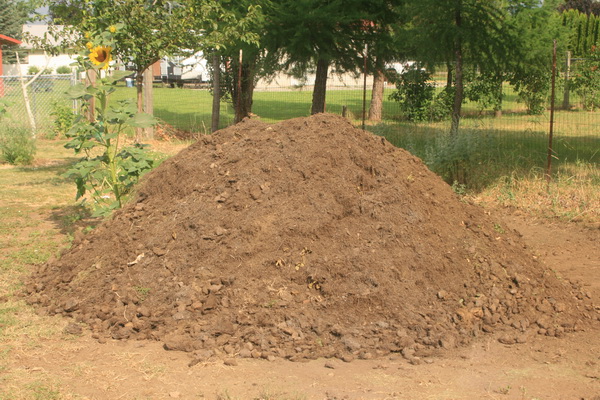 Well, I'm all finished now. It really doesn't take long and it's going to be great in the garden next spring. |
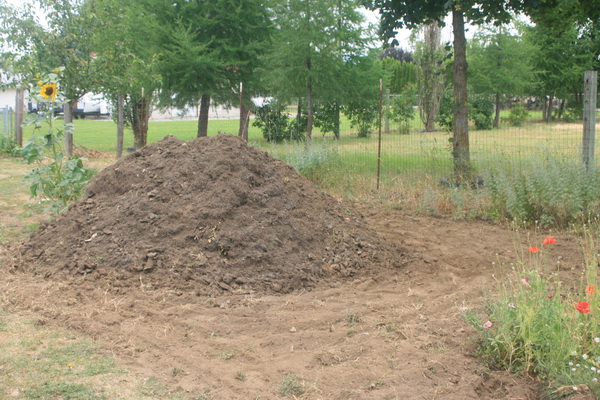 I have tilled around the pile here because next spring I plan to make this the corn or squash patch. This way, every time I turn the pile it will add some of it to the soil and I should have a really great corn (or squash) patch. |
|
| If you have any questions I will be happy to help if you E-Mail me Here. | ||
While yard trimmings recovery typically involves leaf compost and mulch, yard trimmings can also be combined with other organic waste, such as food residuals, animal manure, and biosolids to produce a variety of products with slightly different chemical and physical characteristics. In contrast to yard trimmings recovery, only 2.6 percent of food waste was composted in 2000. The cost-prohibitive nature of residential food waste separation and collection is the primary deterant to expanding food waste recovery efforts. Yet in many communities, edible food residuals are donated to the needy, while inedible food residuals are blended into compost or reprocessed into animal feed. In some areas, composting operations are working with high-volume commercial and institutional food producers to recover their food byproducts, saving these firms significant disposal costs. For more information on organic materials, visit the EPA's Organic Materials Web site.
Horse, Cow, Goat, Rabbit, Chicken - Whatever eats grasses and seeds and other organics. Not from animals that eat meat.
I make my own. I get hardwood logs and make it my self. I put all my logs in a pile, get a good fire going really hot, then cut off it's oxygem. That's pretty much a simplified version. For more complete instructions look here: How to make Charcoal #1 Or here: How to make Charcoal #2 I actually made it using my compost pile to cut off the oxygen to the fire. It cooked for 2 days under the pile and I had to wet it down several times and seal up places where it burned through to the outside. But, it worked very well.
Ashes will change the PH of your pile Wood ash does have fertilizer value, the amount varying somewhat with the species of wood being used. Generally, wood ash contains less than 10 percent potash, 1 percent phosphate and trace amounts of micro-nutrients such as iron, manganese, boron, copper and zinc. Trace amounts of heavy metals such as lead, cadmium, nickel and chromium also may be present. Wood ash does not contain nitrogen. The largest component of wood ash (about 25 percent) is calcium carbonate, a common liming material that increases soil alkalinity. Wood ash has a very fine particle size, so it reacts rapidly and completely in the soil. Although small amounts of nutrients are applied with wood ash, the main effect is that of a liming agent. Increasing the alkalinity of the soil does affect plant nutrition. Nutrients are most readily available to plants when the soil is slightly acidic. As soil alkalinity increases and the pH rises above 7.0, nutrients such as phosphorus, iron, boron, manganese, copper, zinc and potassium become chemically tied to the soil and less available for plant use. Applying small amounts of wood ash to most soils will not adversely affect your garden crops, and the ash does help replenish some nutrients. But because wood ash increases soil pH, adding large amounts can do more harm than good. Keep in mind that wood ash that has been exposed to the weather, particularly rainfall, has lost a lot of its potency, including nutrients.
Actually, it's usually easier to leave grass clippings in the lawn, where they will decompose and benefit the soil directly. However, they can be composted, too. Be cautious to add grass clippings in very thin layers, or thoroughly mix them in with other compost ingredients, as they otherwise tend to become slimy and matted down, excluding air from the pile. Fresh grass clippings are high in nitrogen, making them a 'green' compost ingredient.
Farmers are often very happy to get rid of spoiled hay bales that have been out in the rain, and will give them away or sell them at a low price. Grass hay will probably contain a lot of seed, which can resprout in your garden. Alfalfa hay will compost very readily. The greener the hay, the more nitrogen it contains. Be sure that any hay you plan to compost is well-moistened prior to addition to the pile.
Fruit and vegetable peels/rinds, tea bags, coffee grounds and filters, eggshells, and similar materials are great stuff to compost. They tend to be high in nitrogen (this puts them in the 'greens' category), and are usually quite soft and moist. As such, kitchen wastes need to be mixed in with drier/bulkier materials to allow complete air penetration. Many people compost their kitchen wastes in enclosed worm bins or bury them 8" deep in the soil, to keep from attracting pests to an outdoor compost pile (check with your local government to see if it has regulations about this -- some forbid open piles containing food wastes because of the pest issue). Avoid composting meat scraps, fatty food wastes, milk products, and bones -- these materials are very attractive to pests.
If you live in an area where autumn leaves are still thrown away as garbage, cash in on the bounty each year by acquiring your neighbors' leaves! Generally, leaves are an excellent compost ingredient. They can mat down and exclude air, though, so be sure that any clumps are thoroughly broken up, or that the leaves are only used in very thin layers. Ash and poplar/cottonwood leaves can raise soil pH if used in compost -- this may not be beneficial if your soil is already alkaline, as many soils are in the West (especially in semiarid and arid climates). Dead, dry leaves are in the 'browns' category, while living green leaves contain abundant nitrogen and are considered 'greens'.
Both Pearlite and Vermiculite will add soil conditioners to your pile and later your garden. Additionally, will help to break up or avoid matting and clumping of greens. Furthur they will help aerate your pile
Dry straw is a good material for helping to keep a compost pile aerated, because it tends to create lots of passageways for air to get into the pile. Be sure to wet the straw, as it is very slow to decompose otherwise. Straw is definitely a 'brown' and also requires mixture with 'greens' to break down quickly. Many stables use straw as a bedding material for horses -- straw that has undergone this treatment is mixed in with horse manure and breaks down more quickly.
Wood products belong in the 'browns' category, because they are fairly low in nitrogen. Some sawdusts, especially from broadleaved/deciduous tress, will break down quickly in an active compost pile. Others, especially from coniferous trees, will take longer to decay. Stir sawdust thoroughly into the pile or use very thin layers. Coarse wood chips will very slowly decay, and are probably better used as mulch unless you have lots of time to wait. Be sure not to compost chips or sawdust from any sort of chemically-treated wood -- you could be adding toxics like arsenic to your pile if you do.
Many types of weeds and old garden plants can be composted. Avoid weeds that have begun to go to seed, as seeds may survive all but the hottest compost piles. Some types of weeds are 'pernicious weeds' and will resprout in the compost pile -- avoid using these unless they are thoroughly dead. Green weeds are (you guessed it) a 'green', while dead brown weeds are a 'brown'.
That's right - Pee on your Pile
Note:
This might be obvious but, I thought I'd say it anyway. The smaller particle
size you use in your pile the faster it will decompose.
Releases substances that might be harmful to plants
Sawdust is often available from constructions sites, friends, or your own building projects. If you are considering composting sawdust, be sure of the origin of the sawdust. Sawdust from chemically-treated wood products can be bad stuff to compost. For example, take pressure-treated wood (sometimes called CCA), which usually has a greenish tint to it (I have also seen it in other colors). It contains arsenic, a highly toxic element, as well as chromium and copper. There is evidence to suggest that arsenic is leached into the soil from these products when they are used to make compost bins or raised beds, so composting the sawdust would certainly be a mistake. You may wish to read the 'Letters' section of Organic Gardening, April 1994 and July/August 1992, for more information. Avoid other chemically-treated wood products and sawdust as well, such as wood treated with creosote or 'penta' preservative. Additionally, Chemically-Treated Wood is treated so as to make it less susceptable to rotting - something you want your pile to do.
Might contain substances harmful to plants
Create odor problems and attract pests such as rodents and flies. Egg shells are fine and add calcium to the soil
Many plant disease organisms are killed by consistent hot composting, but it's difficult to make sure that every speck of the diseased material gets fully composted. It's best not to compost diseased plant material at all, to avoid reinfecting next year's garden.
Create odor problems and attract pests such as rodents and flies
Human feces can contain disease organisms that will make people very sick. Composting human feces safely requires that the compost pile reach high (thermophilic) temperatures over a period of time. It isn't necessarily that difficult to reach these temperatures in a home compost pile, but the potential health costs of improper composting are high. Composting of human feces should not be attempted, except by experienced 'hot pile' composters who are well informed of the temperatures and times required to kill pathogens, and who are willing to take 100% responsibility for the process and product.
These materials are very attractive to pests (in an urban setting, this could mean rats...). In addition, fatty food wastes can be very slow to break down, because the fat can exclude the air that composting microbes need to do their work.
Morning glory/bindweed, sheep sorrel, ivy, several kinds of grasses, and some other plants can resprout from their roots and/or stems in the compost pile. Just when you thought you had them all chopped up, you'd actually helped them to multiply! Don't compost these weeds unless they are completely dead and dry (you may want to leave them in a sunny place for a couple of weeks before composting). Remember also that composting weeds that have gone to seed will create weeds in next year's garden, unless a very hot pile temperature can be maintained to kill the seeds.
However, If you just throw these on the top for a day or so before turning them into the pile it should be OK since the heat of day and dry air will kill them good. Also, if you turn the pile often, any seeds that sprout and any weeds that try to take hold will never get a chance to establish themselve.
Might contain parasites, bacteria, germs, pathogens, and viruses harmful to humans. It is best NEVER to use them in compost piles. Some people do bury them 8" deep in the soil, but ONLY in areas where food crops are never grown.
Might kill beneficial composting organisms
NOTE: Finished compost can be applied to lawns and gardens to help condition the soil and replenish nutrients. Compost, however, should not be used as potting soil for houseplants because of the presence of weed and grass seeds. Also, the high nutrient content can harm or even kill houseplants
Here is an additional comprehensive Recycling resource for you to check out from Home Advisor Environmental Home Remodeling: Recycling and Composting
Cindy Powell From The Girl Scouts of America sent me this link for those of you who live in Apartments and want to compost Guide to Apartment and Condo Composting by Brian Enright. Thank you Cindy!
Basically it just involves using bublers and steeping your compost in water for a couple or 3 days.
Perhaps later I will write my own guide for making compost tea but, for now here is a good explanation and guide: Making Compost Tea